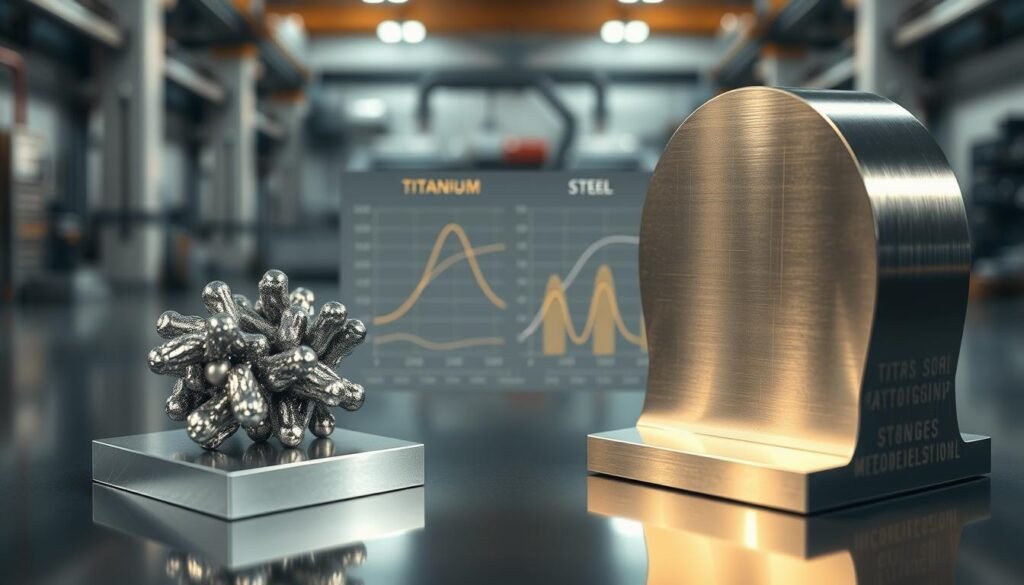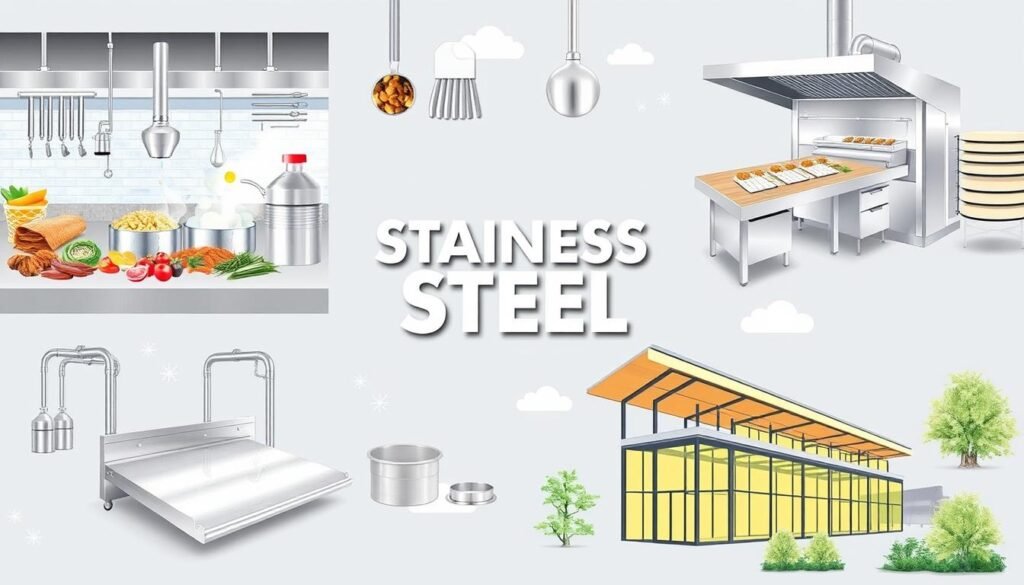When it comes to choosing between titanium and stainless steel for various applications, understanding their properties and strength is crucial.
The debate surrounding the strength of these two metals has been ongoing, with each having its own set of advantages and disadvantages.
Titanium is known for its high corrosion resistance and strength-to-weight ratio, making it an ideal choice for industries such as aerospace and medical.
On the other hand, stainless steel is renowned for its durability and resistance to corrosion, with various grades offering different levels of strength and properties.
This comprehensive guide will delve into the comparison between titanium and stainless steel, examining their performance in different environments and applications.
Understanding Titanium and Stainless Steel
The debate between titanium and stainless steel often begins with understanding the fundamental properties of these metals. Both are widely used in various industries due to their unique characteristics.
What is Titanium?
Titanium is a strong, lightweight metal known for its high strength-to-weight ratio and corrosion resistance. It is used in aerospace, medical implants, and high-performance sports equipment. Titanium alloys are created by combining titanium with other elements to enhance its properties.
Titanium’s key advantages include its biocompatibility and high melting point, making it suitable for applications where exposure to extreme temperatures is common.
What is Stainless Steel?
Stainless steel is not a single material but a family of iron-based alloys containing a minimum of 10.5% chromium. This chromium content provides superior corrosion resistance compared to regular carbon steel. There are over 150 grades of stainless steel, categorized into five main types: austenitic, ferritic, martensitic, duplex, and precipitation-hardening.
| Type of Stainless Steel | Characteristics | Common Applications |
|---|---|---|
| Austenitic | Non-magnetic, corrosion-resistant | Kitchen appliances, industrial equipment |
| Ferritic | Magnetic, less corrosion-resistant than austenitic | Automotive exhaust systems, decorative trim |
| Martensitic | Strong, magnetic, less corrosion-resistant | Cutlery, turbine blades |
Comparing the Basic Properties
To determine the suitability of titanium and stainless steel for different uses, it’s essential to compare their basic properties. This comparison will help in understanding which material is more appropriate for specific applications.
Elemental Composition
Titanium is a chemical element with the symbol Ti and atomic number 22, known for its high strength-to-weight ratio and corrosion resistance. Stainless steel, on the other hand, is an alloy primarily made of iron, chromium, and sometimes other elements like nickel and molybdenum, which provide its corrosion-resistant properties.
Crystalline Structure
Titanium has a hexagonal close-packed (hcp) crystal structure at room temperature, which changes to a body-centered cubic (bcc) structure at higher temperatures. Stainless steel can have different crystal structures depending on its grade, such as austenitic, ferritic, or martensitic, influencing its properties.
Density and Weight
The density of titanium is approximately 4.51 g/cm³, significantly lower than that of stainless steel, which ranges from 7.7 to 8.0 g/cm³. This difference in density makes titanium components nearly half the weight of equivalent stainless steel parts.
The substantial weight difference between titanium and stainless steel is critical in weight-sensitive applications. A comparison of their properties is summarized in the following table:
| Property | Titanium | Stainless Steel |
|---|---|---|
| Density (g/cm³) | 4.51 | 7.7-8.0 |
| Strength-to-Weight Ratio | Excellent | Good |
| Modulus of Elasticity (GPa) | 110 | 200 |
This comparison highlights the advantages of titanium in applications where weight is a critical factor, such as in aerospace, due to its superior strength-to-weight ratio and lower density.
Is Titanium Stronger Than Stainless Steel?
To determine if titanium surpasses stainless steel in strength, we must first understand what strength means in the context of metals. Strength in metals refers to the ability of a material to withstand external forces without failing or deforming excessively.
Defining Strength in Metals
Strength is a critical property of metals, encompassing various metrics including tensile strength, yield strength, and strength-to-weight ratio. Tensile strength is the maximum stress a material can withstand while being stretched before failing. Yield strength is the stress at which a material begins to deform plastically.
Tensile and Yield Strength Comparison
When comparing titanium and stainless steel, it’s observed that while some high-strength stainless steels may have higher tensile and yield strengths than titanium alloys, titanium’s lower density gives it a significant advantage. For instance, certain stainless steels can have tensile strengths up to 860 MPa, but their density is around 8.0 g/cm³.

Strength-to-Weight Ratio
The strength-to-weight ratio, or specific strength, is a measure of a material’s strength relative to its density. Titanium excels in this metric, with specific strength values typically 1.5 to 2 times higher than stainless steel. This makes titanium ideal for weight-critical applications such as aerospace components and high-performance sporting equipment.
For example, titanium alloy Ti-6Al-4V has a tensile strength of 900 MPa and a density of 4.43 g/cm³, giving it a specific strength of 203.2 kN·m/kg, significantly higher than many stainless steels.
Durability and Resistance Factors
Material selection often hinges on durability and resistance factors, particularly in demanding environments. Both titanium and stainless steel are known for their durability, but they exhibit different resistance characteristics that make them suitable for various applications.
Corrosion Resistance
Titanium is renowned for its excellent corrosion resistance, attributed to its naturally occurring oxide layer that protects it from various corrosive environments. Stainless steel also offers good corrosion resistance, thanks to its chromium content, although it can be susceptible to certain types of corrosion under specific conditions.
Temperature Resistance
Titanium maintains its strength and resistance at high temperatures, making it ideal for aerospace and high-temperature applications. Stainless steel, while capable of withstanding high temperatures, may lose some of its strength and corrosion resistance at extreme temperatures.
Impact and Wear Resistance
Stainless steel generally exhibits superior hardness and wear resistance compared to titanium. However, titanium’s excellent impact resistance and toughness make it suitable for applications subject to sudden loads or impacts. Surface treatments can significantly improve the wear resistance of both materials.
The choice between titanium and stainless steel involves trade-offs between properties like hardness, impact resistance, and corrosion resistance. Understanding these factors is crucial for selecting the most appropriate material for specific applications.
Manufacturing and Processing Considerations
Understanding the manufacturing and processing differences between titanium and stainless steel is essential for material selection in various industrial applications.
Machinability
Titanium is known for its challenging machinability due to its high strength, low modulus of elasticity, and tendency to gall and seize during cutting operations. In contrast, stainless steel generally offers better machinability, although certain grades can be difficult to machine due to their high work hardening rates.
Weldability
Steel, including stainless steel, typically exhibits excellent weldability, making it a versatile material for various fabrication processes. Titanium, while weldable, requires more stringent controls, such as inert gas shielding, to prevent contamination and ensure high-quality welds.
Forming and Shaping
The formability of titanium and stainless steel differs significantly. Stainless steel generally offers superior formability, with most austenitic grades being easily cold-formed into complex shapes. Titanium, particularly high-strength titanium alloys, requires more force and often specialized equipment for forming, impacting processing costs.
Cost Analysis: Titanium vs. Stainless Steel
Understanding the cost implications of choosing between titanium and stainless steel is crucial for product design and manufacturing planning. The decision involves not only the raw material costs but also the processing and production expenses.
Raw Material Costs
The raw material cost for titanium is significantly higher than for stainless steel. This is due to the complex and energy-intensive process of titanium extraction and production.
Processing and Production Costs
Beyond the raw material costs, the processing and fabrication of titanium components are more expensive due to its challenging material properties.
| Cost Factor | Titanium | Stainless Steel |
|---|---|---|
| Machining Cost | 3-5 times higher | Baseline |
| Welding Complexity | Highly specialized | Straightforward |
| Heat Treatment | More expensive | Less expensive |
Machining titanium can be 3-5 times costlier than machining stainless steel. The combined processing costs mean a finished titanium component may cost 7-10 times more than an identical stainless steel part.
Advantages of Titanium
With its unique combination of properties, titanium offers several advantages over other metals like stainless steel, making it an ideal choice for various high-performance applications.
Superior Strength-to-Weight Ratio
Titanium is renowned for its exceptional strength-to-weight ratio, which is significantly higher than many other metals, including some types of stainless steel. This property makes titanium an attractive material for industries where weight reduction is critical without compromising on strength.
Excellent Corrosion Resistance
Titanium exhibits outstanding corrosion resistance due to its naturally occurring oxide layer. This characteristic makes it particularly suitable for use in harsh environments where exposure to corrosive substances is common, outperforming many grades of steel.
Biocompatibility
One of the significant advantages of titanium is its biocompatibility, making it an ideal material for medical implants and surgical instruments. Its inertness ensures that it does not react with the human body, reducing the risk of adverse reactions.
High Melting Point
Titanium has a high melting point of approximately 1,668°C (3,034°F), which is higher than many types of stainless steel. This property makes titanium particularly valuable in aerospace applications and other high-temperature environments where maintaining structural integrity at high temperatures is crucial.
Advantages of Stainless Steel
The advantages of stainless steel are multifaceted, making it a versatile choice for different applications. This versatility stems from its various beneficial properties.
Cost-Effectiveness
One of the primary advantages of stainless steel is its cost-effectiveness. Compared to titanium, steel is generally less expensive to produce and process, making it an attractive option for projects where budget is a concern.
Versatility and Availability
Stainless steel is highly versatile and widely available. Austenitic stainless steels like 304 and 316 can be easily formed into complex shapes without cracking, offering a significant advantage over titanium.
Superior Hardness
The hardness of steel is another significant benefit. Stainless steel exhibits superior hardness compared to titanium, making it suitable for applications where durability is crucial.
Excellent Workability
Stainless steel is known for its excellent workability. It can be machined, welded, and formed with ease, reducing manufacturing and processing costs. This workability translates to lower production times and costs.
Common Applications
The versatility of titanium and stainless steel makes them indispensable in a wide range of industrial applications.
Titanium Applications
Titanium is valued for its high strength-to-weight ratio, corrosion resistance, and ability to withstand extreme temperatures. It is used in:
- Aerospace industry for aircraft parts and engine components due to its lightweight and high strength.
- Medical implants, such as hip and knee replacements, because of its biocompatibility and resistance to corrosion.
- Marine applications, including propeller shafts and other equipment exposed to seawater, due to its resistance to saltwater corrosion.

Stainless Steel Applications
Stainless steel is widely used due to its corrosion resistance, durability, and aesthetic appeal. Its applications include:
- Food processing and kitchen equipment, where its ease of cleaning and resistance to corrosion are crucial.
- Medical and pharmaceutical equipment, benefiting from its durability and ability to be sterilized.
- Architectural features, such as handrails and building facades, due to its aesthetic appeal and low maintenance.
- Transportation industry, including automotive and railway components, where its strength and resistance to corrosion are valuable.
- Industrial equipment and infrastructure, such as chemical processing equipment and water treatment facilities, due to its resistance to corrosive environments.

Choosing Between Titanium and Stainless Steel
When deciding between titanium and stainless steel for a specific application, several factors come into play. The decision hinges on the material’s properties, cost, and the environment in which it will be used.
When to Choose Titanium
Titanium is the preferred choice in applications where its unique properties offer significant advantages. Its superior strength-to-weight ratio and excellent corrosion resistance make it ideal for use in harsh environments, such as in aerospace, medical implants, and high-performance sports equipment.
When to Choose Stainless Steel
Stainless steel is often selected for its cost-effectiveness, ease of fabrication, and wide range of alloys available. It is suitable for applications requiring good corrosion resistance and mechanical properties, such as in commercial kitchen equipment, architectural features, and consumer products. Additionally, stainless steel is preferred in high-temperature applications and situations where superior hardness and wear resistance are necessary.

Conclusion
When evaluating titanium versus stainless steel, it becomes clear that the notion of “strength” is multifaceted, encompassing various dimensions such as tensile strength, yield strength, hardness, and strength-to-weight ratio.
Titanium and stainless steel each excel in different categories, making the choice between them dependent on specific application requirements. While many grades of stainless steel offer higher absolute tensile and yield strength, titanium‘s exceptional strength-to-weight ratio makes it ideal for weight-critical applications.
Both materials exhibit excellent corrosion resistance, with titanium generally outperforming stainless steel in extreme environments. The decision between these materials should be based on a thorough analysis of mechanical loads, environmental conditions, weight constraints, and budget limitations.
For most commercial applications where moderate corrosion resistance and good mechanical properties are required, stainless steel offers the best value. However, when maximum performance, minimal weight, or extreme durability is necessary, titanium remains the material of choice, justifying its premium price for high-quality materials in demanding applications or project requirements.
